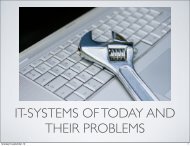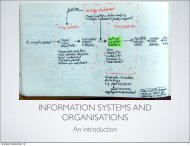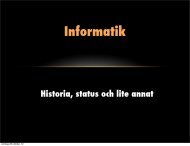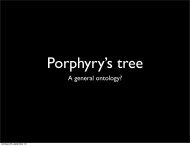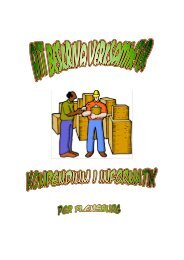Flensburg P: Personlig databehandling - Per Flensburgs hemsida
Flensburg P: Personlig databehandling - Per Flensburgs hemsida
Flensburg P: Personlig databehandling - Per Flensburgs hemsida
Create successful ePaper yourself
Turn your PDF publications into a flip-book with our unique Google optimized e-Paper software.
<strong>Per</strong> <strong>Flensburg</strong>: <strong><strong>Per</strong>sonlig</strong> <strong>databehandling</strong><br />
• To document my own thoughts before the real data collection started.<br />
The interviews were conducted using a tape recorder to avoid having to take notes<br />
which might have inhibited the interview. Thus only references to the prepared set of<br />
questions was necessary. On conclusion the interviewee was provided with the set of<br />
questions to check if any important or interesting questions remained unanswered.<br />
Currently I have two levels of documentation, firstly the tape-recorded interviews and<br />
secondly the interviews as subsequently written up in a coherent form. This requires<br />
some interpretation of the collected material. A typical interview took about 1 to 1.5<br />
hour and occupied about 8 to 9 full pages of text when written up. When I had conducted<br />
the interviews I tried to write them up immediately. Some interviews have<br />
been done by students or other researchers and they were unable to do it this way, for<br />
example have some interviews been done at companies far away, so people have had<br />
to stay at an hotel over night. The written up versions were sent back to the interviewed<br />
people for comments and corrections. Then I called back after about a week to<br />
check if my documentation was correct and to see if any of the set of questions were<br />
unanswered. When they had agreed the written interviews became an official version<br />
and could be distributed.<br />
The material has to be confidential as some interviews reveal information of sensitive<br />
nature that cannot be published or alluded to. I thus have to write in such a way that<br />
the actual applications are only very briefly described and the company and the products<br />
are not mentioned by name. In doing so I hope to guarantee the integrity of the<br />
organizations involved.<br />
7.3.1 Some findings<br />
At present I have 19 interviews from 13 companies and some patterns are emerging.<br />
The first finding indicates the existence of the local experts, that is people who know<br />
how to use the tools and help other people in their work. These local experts work<br />
with the computer tools as a part of their job. They frequently have a relatively high<br />
position in the organization, working close to the head of the department or maybe<br />
the company. In one case the local expert was the head of the purchase department.<br />
They were all enthusiastic about the possibilities this new way of working provided.<br />
They often became more influential and felt more valued by the head of the department<br />
or the company.<br />
Another finding is that they use more than one tool. Typically there were tools for<br />
data bases (query languages), calculations, graphics and word processing. The tools<br />
are supplied by an information center at the data processing department. At this<br />
center two or three persons work as advisors and teachers concerning the use of these<br />
tools. APL is often used as a host or base language. This reflects the fact that IBM<br />
uses this in their information center idea.<br />
191



